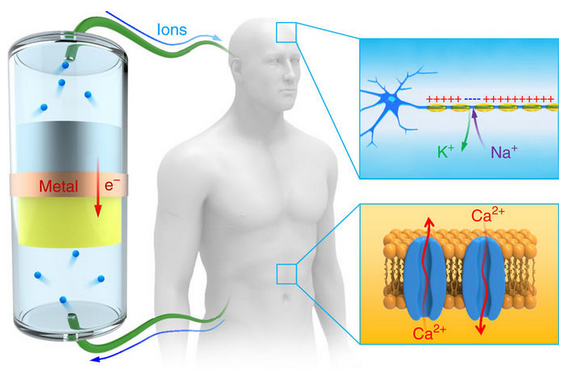By Brian Santo, contributing writer

Some people love the smell of freshly cut grass because it signals mental associations with summer. A group of researchers at the University of Maryland love it when the groundskeepers mow the lawn because each cut blade of grass can be used as a cable for a unique battery that can deliver ionic signals to instigate mental impulses. Welcome to science.
Pretty much every battery ever developed in the history of batteries supplies an electric current through a wire. The Maryland team has developed what they believe may be the first battery to ever deliver an ionic current. And because the materials used for most wires (such as metal, carbon, semiconductors, etc.) cannot conduct ions, the researchers had to find materials that could; they’re using things like cotton string, as well as grass they literally went outside and plucked from the campus lawn.
Everyone knows that biological organisms operate on electrical impulses; these impulses are the basis of electrocardiograms (EKGs), electroencephalograms (EEGs), and Keanu Reeves plugging himself into The Matrix. What’s less widely understood is that these biological impulses are ionic, not electric. When a synapse fires, it’s not transmitting electrons, it’s transmitting sodium ions. Similarly, muscle cells fire based on ions crossing ion channels in molecular membranes.

The differences between the traditional battery versus the electron battery when interacting with an ionic system. Source: Nature.com.
Of course, it is possible to stimulate biological processes with an electric current, but that results in electrochemical reactions that tend to disrupt and sometimes harm biological systems, according to the paper describing the new battery.
Ionic current would provide more precise monitoring, powering, and activation, but all attempts thus far at interfacing with ion-triggered biological systems by necessity involved somehow converting electric current to ionic current.
What if an ionic current could be produced and delivered directly? There is ionic activity in electric batteries, but that activity is designed to produce electric current and is confined within the battery. The Maryland researchers wondered if it was possible to invert the design of the battery.
They’ve demonstrated that it is possible. In their paper, they introduce their new battery by contrasting it with traditional ones: “A traditional battery includes the cathode and anode, which are connected by an ionic medium (for example, liquid electrolyte); externally, the electrons travel through a circuit to power devices. Oppositely, the inside of an electron battery is connected by an electrical conductor that only allows electrons to be transported from the negative to the positive electrode, while the ions flow through ionic cables and are transported externally to create a circuit of ions.”
The ionic cables, as noted above, are strings or grass soaked in electrolytes. There are polymers and ceramics that will serve, but the researchers say that they all have inferior conductivity and flexibility compared to the solutions that they are using.
The researchers provided details of the construction of their electron battery: It has a lithium metal anode and a vanadium oxide cathode. Both the anode and the cathode are sealed in glass tubes filled with organic electrolyte. “One end of the glass tube is sealed with the ion exchange membrane (IEM), which retains the electrolyte and allows ions to pass through,” says the paper. “The electrodes are connected with an electrically conductive wire that allows the transport of electrons and serves as the internal circuit.” The grass cables are attached onto the IEM of each electrode to conduct ions and serve as the external circuit.
The next steps will include determining if it is possible to create a version of the electron battery that is practical for medical applications. Those applications could include precise manipulation of brain signaling, which could be useful to control any number of disabilities that have neurological causes.
Advertisement
Learn more about Electronic Products Magazine





